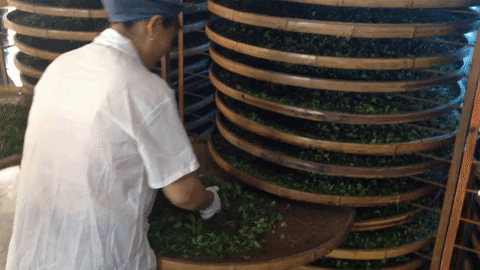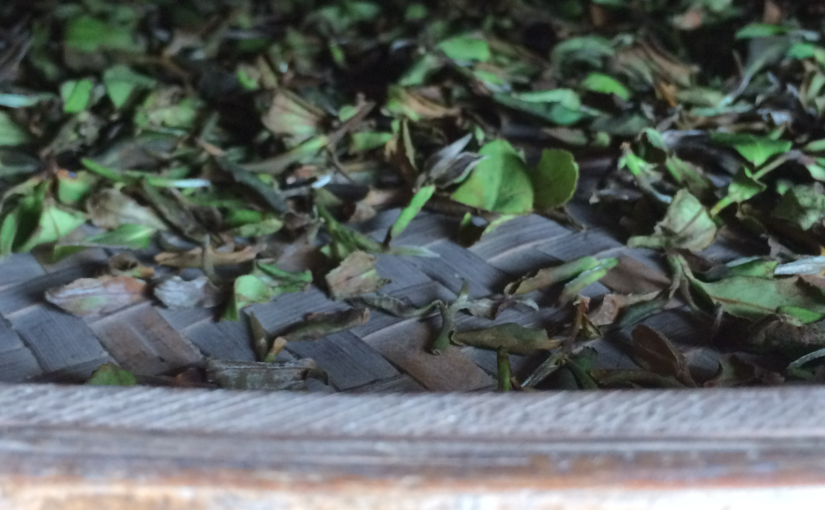When introducing someone to the world of loose-leaf tea, I often describe oolong1 as being sort of in-between green tea and black tea. If a slightly longer explanation is appropriate, I describe the process of making black tea as oxidation (AKA enzymatic browning), where chemicals in the leaves turn brown after the leaves are crushed, and that green tea has been heated to prevent this chemical reaction from happening. Oolong has been allowed to experience a little bit of oxidation before heating, so it’s in-between. But in reality, this is a gross oversimplification. The differences between oolong and black tea processing are much greater than simply the amount of time oxidation happens, and there’s a lot of different things going on physiologically and chemically with the tea leaves.
To ensure that tea is completely oxidized in black tea processing, tea leaves are typically crushed or rolled strongly after withering to break open leaf cells and release their juices so that catechins mix with enzymes in the presence of air to ensure an even and complete oxidation. This reaction relies on enzymes and precursors that are already contained in the leaf cells. The crushing just allows them to mix and react with oxygen.
Oolong tea processing, on the other hand, does not generally involve crushing tea leaves, but rather starts with a gentler bruising, often called yáo q?ng or “rocking the green”. This may involve “fluffing” the withered leaves by hand every so often, or maybe placing the leaves in a large basket tumbler that rotates slowly. Both of these actions only gently damage the leaf edges where they will gradually turn brown, while the inside of the leaf is still green. Not only is the center of the leaf green, but it is alive during this step of processing. This, I’ve come to believe, is the major distinguishing feature of oolong tea, not its oxidation levels. This makes oolong tea more similar to white tea, which only undergoes a slow air drying, than to either green or black tea.

Oolong processing involves not only the oxidation of catechins in crushed leaf cells, but also a whole lot of other chemical reactions going on in the living, intact cells in the center of the leaf. These cells are experiencing a lot of stress—they’ve been severely wilted and their neighbors on the edge of the leaf are being damaged by yáo q?ng and this causes them to ramp up all sorts of chemical defenses. This is evident when you look at the gene expression (a measure of which and how many genes are turned up or turned down) of tea leaves undergoing oxidation in oriental beauty processing, reported by Cho and others in a 2007 research paper. They found thousands of genes were activated during yáo qÄ«ng—many of them associated with stress. Many of these genes were responsible for encoding the production of enzymes that make aroma chemicals.
In other words, tea leaves undergoing yáo qīng sensed damage that would ordinarily come from something eating them, and in a last-ditch effort they produced a bunch of defense chemicals that just happen to be really tasty to humans. Many of the genes that were activated in oolong production require intact, living plant cells to do their jobs, which are much more abundant in oolong processing compared to black tea processing where many more leaf cells are ruptured by rolling or crushing the leaves.
Cho and others also measured the aroma chemicals in leaves throughout processing and saw that many aroma chemicals increased dramatically during processing, some up to 400 times greater than in fresh leaves. Â In my own preliminary research comparing tea leaves before and after processing, many important aroma chemicals increase in concentration as a result of processing in oriental beauty tea including methyl salicylate, which not only contributes to tea flavor (it’s the main flavor constituent of wintergreen), but is also an important plant hormone produced by plant cells after sensing damage.
Rather than simply being differentiated from green and black teas by what percentage of the catechins are oxidized, I’d argue that there is a more important distinguishing characteristic of oolongs. Many of the floral or fruity aromas of oolong teas that make them so alluring might be produced “from scratch” by living cells in tea leaves during the slow, methodical processing of oolong teas. The fact that oolong leaves are alive (and stressed) for longer than green or black teas is what makes them more than just “mid-oxidized”.
Acknowledgements:
I’d like to thank Dr. Yang Zi-Yin from the Chinese Academy of Agricultural Sciences (CAAS) for inspiration and Dr. Li Xin from the Tea Research Institute in Hangzhou for taking pictures of Dr. Yang’s talk for me, translating it, and discussion.
Citations:
Cho J-Y, Mizutani M, Shimizu B-I, et al (2007) Chemical Profiling and Gene Expression Profiling during the Manufacturing Process of Taiwan Oolong Tea “Oriental Beauty.†Bioscience, Biotechnology and Biochemistry 71:1476–1486. doi: 10.1271/bbb.60708
Footnotes
1 The correct Pinyin transliteration for this word is “wulong”, but I’ve chosen to use “oolong” because it’s probably a more common spelling in English speaking countries.
